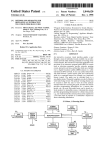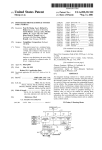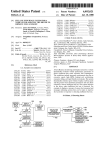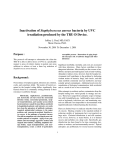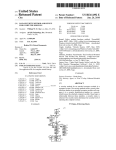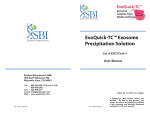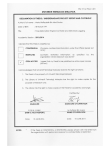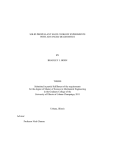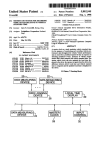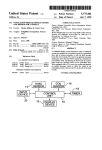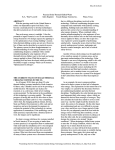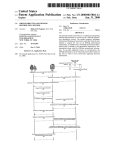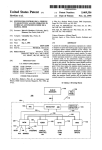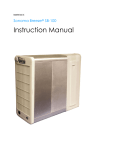Download 20w 22?
Transcript
US005957986A Ulllted States Patent [19] [11] Patent Number: Coverdill [45] [54] Date of Patent: METHOD AND SYSTEM FOR RECORDING 5,303,163 4/1994 Ebaugh et a1. ........................ .. 340/439 5,526,269 5,452,446 6/1996 9/1995 Johnson Ishibashi ....... et 211... - - [75] Inventor‘ [73] Assigneez Freightliner Corporation, Portland, Cary N‘ Coverdln’ Bonng’ 0mg‘ 5,594,646 1/1997 ItOll et a1. ..... .. 5,600,558 2/1997 Mearek et al. ........................ .. 340/438 5,650,930 7/1997 Hagenbuch ............................. .. 701/35 5,802,545 9/1998 C0verd1ll ................................ .. 701/35 OregNotice; OTHER PUBLICATIONS This patent is Subject to a terminal disClaitmm Owner’s Manual Caterpillar Driver Information Display, Caterpillar, Feb. 1995. ProDriverTM User Manual, Detroit Diesel Corporation, [21] Appl. NO.Z 09/137,553 [ 22 1 *Sep. 28, 1999 VEHICLE STANDARD DATA TIME RELATIVE TO VEHICLE _ [*] 5,957,986 F1 d: 16 A Man’ 1994 CELECT RoadRelayTMUser’s Guide, Curnrnins Cadec. .20 1998 ug ’ Primary Examiner—Gary Chin Related US Application Data Attorney, Agent, or Firm—Klarquist Sparkrnan Campbell Leigh & Whinston LLP 7 63 7 Continuation of a Pat. NO. 5,802,547577 lication No. 08 652 776 Ma 23 1996 / 7 7 y 7 7 [57] ABSTRACT [51] Int. Cl? .................................................... .. G06F 17/00 A master clock on a truck maintains Vehicle Standard time [52] us. Cl. .............................. .. 701/35; 701/29; 340/438 for the Purposes of monitoring 919 recording Vehicle Per [58] Field Of Search ...................... .. 701/29 35- 340/438 ’ ’ 340/439’ formance data throughout the Vehlcle' Vehlcle Performance data is stored for a prede?ned period of time in response to detecting prede?ned events. Instances of vehicle perfor [56] References Cited rnance data are time stamped with vehicle standard time. The master vehicle clock can also maintain the local time US. PATENT DOCUMENTS displayed to the driver. In response to inputs from the driver, 4,258,421 3/1981 JuhasZ et a1. ........................... .. 701/35 4,533,962 8/1985 Decker et a1. 360/5 10/1993 Koyanagi time is. computed and the updated local time is displayed to 701/35 5,173,856 12/1992 Purnell et a1. 5,250,761 the difference between driver local time and Vehicle Standard ......... .. the driver. 701/35 5,253,224 10/1993 Van Doesburg ...................... .. 340/438 3 Claims, 7 Drawing Sheets 20w 22? DATA MEASURING DEVICE DATA MEASURING DEVICE I I DATA LOGGING DEVICE j 26 l I I DATA MEASURING w DEVICE 24 7 LOCAL TIME DISPLAY D A AI 30 7 I I I MASTER CLOCK INPUT CONTROL / 28 / 32 l U.S. Patent Sep.28, 1999 Sheet 1 of7 5,957,986 FIG. 1 20w 22? DATA MEASURING DEVICE DATA MEASURING DEVICE I I DATA LOGGING DEVICE q 26 I LOCAL TIME DISPLAY ‘9 I I ( I I I DATA MEASURING w DEVICE 24 so I I I I I MASTER CLOCK INPUT CONTROL 28 32 l U.S. Patent Sep.28, 1999 (- DOOR 94 SENSORS Sheet 3 of7 HVAC SENSORS 5,957,986 PARKING q BRAKE SENSORS 98 \ COOLANT 96 F|G.3 LEVEL ‘W SENSOR 10o A/D __ Vg?’?g w /OONvERTERS SENSOR 102 106 TLIRN SIGNALS w 104 110w TO DATA F LOGGING UNIT 903 : DISPLAY KEYPAD DEVICE “92 82 MEMORY 8O J ROM F ~ ‘ ‘E 38 ‘ CPU ‘ PORT EEPFKDMw 86 “ INTERFAOE 84 k / 40 2 108 " BUZZER U.S. Patent Sep. 28, 1999 FIG. 7A 5,957,986 Sheet 6 0f 7 RECEIVE TIME/DATE DATA I COMPUTE CHANGE IN TIME/DATE x262 CONSTRUCT MESSAGE \ 264 I SEND MESSAGE TO DATA LOGGING UNIT RECEIVE UPDATE IN TIME/DATE FROM DATA LOGGING UNIT II END FIG. 78 RECEIVE MESSAGE FROM ICU I UPDATE DELTA IN BUFFER I RETURN TIME/DATE MESSAGE I END \ 270 U.S. Patent Sep. 28, 1999 FIG. 8A Sheet 7 0f 7 RECEIVE INPUT FROM KEYPAD II CONSTRUCT MESSAGE I BROADCAST REQUEST FOR TIME/DATE II RECEIVE RESPONSE FROM DATA LOGGING UNIT II DISPLAY TIME/DATE V END FIG. 88 RECEIVE REQUEST FOR TIME/DATE II COM PUTE DRIVER LOCAL TIME V BROADCAST TI ME/DATE V END 5,957,986 5,957,986 1 2 METHOD AND SYSTEM FOR RECORDING VEHICLE DATA RELATIVE TO VEHICLE STANDARD TIME standard time and for conveniently displaying local time in the cabin of the vehicle. The invention further provides a master clock for maintaining vehicle standard time, and a system for recording vehicle data. In this context, vehicle RELATED APPLICATION DATA standard time refers to a time reference or time standard in a truck against Which the timing of performance data mea sured throughout the vehicle may be recorded. Vehicle This application is a continuation of US. application Ser. No. 08/652,776, now US. Pat. No. 5,802,545, entitled standard time can also serve as a reference point for com METHOD AND SYSTEM FOR RECORDING VEHICLE DATA RELATIVE TO VEHICLE STANDARD TIME, by Cary N. Coverdill, ?led May 23, 1996, Which is hereby puting the local time displayed to the driver. Vehicle local 10 FIELD OF THE INVENTION The invention relates generally to data management and storage systems for vehicles, and more speci?cally relates to a vehicle clock capable of maintaining standard vehicle time 15 vehicle standard time, and also maintains driver local time. One speci?c Way to maintain driver local time is to keep track of the difference betWeen the local time and the vehicle time, and compute the local time, upon request, from the vehicle standard time and the difference value. In one embodiment, a truck includes a data logging device and a driver local time. BACKGROUND OF THE INVENTION time is variable and is typically adjusted by a driver as a time Zone is passed. In one embodiment, a master clock maintains incorporated by reference. 20 for recording vehicle performance data relative to vehicle standard time. The data logging device monitors vehicle performance data such as road speed, engine speed, coolant In the trucking industry, it is important to accurately temperature, etc. provided by data measuring devices maintain time for the bene?t of both the driver and for service technicians. Since a truck driver frequently travels across time Zones, it is helpful to provide a clock in the cabin that is easy to change With the change in time Zones. In vieW of this fact, it is quite common for trucks to have clocks in the cabin that display time and can be reset to the local time. Aside from the convenience to the driver, it is also useful to have a clock for keeping track of vehicle operating and diagnostic data. For example, if a problem occurs in the throughout the vehicle. In the process of recording selected data, the data logging device stamps instances of the data With the vehicle standard time from a master vehicle clock. 25 Time stamping refers to the process of associating vehicle standard time With the data. This master clock in this embodiment also maintains driver local time by keeping the problem actually occurred at another time. This can track of the difference betWeen local time and vehicle standard time. A local time display presents the local time in the cabin in the vehicle. If the driver Wants to change the local time, he or she simply increments or decrements the time through an input control. Changes in local time are communicated to the master clock. In one speci?c implementation, the input control and time display are integrated into an instrument control unit. This instrument control unit communicates changes in local time to the master clock, Which keeps track of the current difference betWeen vehicle standard time and driver local time. Further advantages and features of the invention Will become apparent With reference to the folloWing detailed result When an electronic subsystem in a truck records a fault description With reference to the accompanying draWings. 30 transmission, it is useful to knoW precisely When the prob lem occurred. Many of the sophisticated electronic controls in trucks do have a mechanism for keeping track of time. Despite the presence of these electronics on board the truck, the frequent changes in local time and/or the lack of a consistency among time keepers in the vehicle often leads to confusion in identifying When problems on the truck actu 35 ally occurred. This confusion arises, for example, When a driver tells the service technician that a problem occurred at one time and using a time clock that is not consistent With the driver’s time or time used by other subsystems in the vehicle. It is equally confusing When a fault in a subsystem is 40 45 FIG. 1 is a functional block diagram illustrating a vehicle data recording system of an embodiment of the invention. FIG. 2 is a block diagram illustrating the architecture of recorded at one time in a ?rst time Zone and then is recorded again at the same time in a second time Zone. Consider for example, a truck travelling West from South Bend, Ind. to Chicago, Ill. If faults are recorded in terms of local time, either by the driver or the truck’s electronics, it is possible data management system on a vehicle. 50 to record a fault at 2:00 PM. in South Bend and a second fault at 2:00 PM. in Chicago. The resulting data erroneously shoWs that the fault occurred tWice at the same time, When in reality, they occurred one hour apart. BRIEF DESCRIPTION OF THE DRAWINGS 55 FIG. 3 is a block diagram illustrating an embodiment of an instrument control unit in the data management system. FIG. 4 is a diagram of the keypad of the instrument control unit shoWn in FIG. 3. FIG. 5 is block diagram illustrating the data logging unit The problems outlined above occur because of the lack of effective means for displaying and keeping track of time in in one embodiment of the invention. the truck. The dif?culty in diagnosing problems in the screens used to set or change drive local time. vehicle are further frustrated by the lack of effective systems for tracking and recording faults detected in the truck. In general, there is a need for an effective system for tracking and recording events on a consistent basis and most prefer ably across all subsystems installed in a truck. SUMMARY OF THE INVENTION The invention provides a method for accurately recording vehicle performance data relative to a master or vehicle FIG. 6 is a diagram illustrating one example of the display 60 FIGS. 7A and 7B are How diagrams illustrating a process for setting the driver local time in one embodiment. FIGS. 8A and 8B are How diagrams illustrating the process for displaying local time in one embodiment. DETAILED DESCRIPTION 65 FIG. 1 is a functional block diagram illustrating a vehicle data recording system of an embodiment of the invention. 5,957,986 3 4 The system includes a plurality of data measuring devices change the local time displayed in the cabin. In one speci?c embodiment, changes in local time are communicated to the (eg 20, 22, or 24) for measuring vehicle performance data. Vehicle performance data can include a variety of vehicle operating, trip, maintenance or diagnostic data such as oil master clock, Which maintains the current difference or pressure, road speed, fuel rate, coolant level, coolant temperature, battery voltage, odometer etc. In addition, such detail regarding a speci?c implementation of the system in “delta” betWeen vehicle standard time and local time. More FIG. 1 folloWs beloW. FIG. 2 is a block diagram illustrating the system archi tecture in a more speci?c implementation of the system shoWn in FIG. 1. The system architecture includes a number vehicle performance data can include fault data such as oil pressure loW, coolant temperature high, high intake manifold air temperature, electrical system or subsystem failure, etc. The vehicle performance data can be measured indirectly via sensors controlled by electronic control units, or directly via 10 discrete sensors or input devices. The data logging device 26 monitors vehicle performance data and potentially records selected instances or “slices” of this data. As alluded to above, the data logging device can receive the vehicle performance data either directly from a 15 of electronic control units (ECUs) coupled together in With a data link 40. In particular, the system includes an instru ment control unit 42, used to control instruments and gauges at the dash of the truck, and a data logging unit 44, used to monitor and record events reported on the data link 40. The illustrated system architecture also includes a number of other electronic units as shoWn, such as a poWertrain ECU 46, an air suspension ECU 48, an antilock brake ECU 50, data measuring device such as a discrete sensor or input and an air conditioning protection unit 52. An ECU typically device, or indirectly through messages from electronic con includes a microprocessor, memory and one or more sensors trol units on a data link. For example, sensors can include a coolant level sensor, a battery voltage sensor, an input device located in the cab of the truck etc. Similarly, the data logging 20 device 26 can be coupled to one or more electronic control units that measure performance data and transfer it to the data logging device via a data link. The data logging device 26 can be programmed to record selected vehicle performance data in response to events. An 25 control units. For instance, a data measuring device can be 30 implemented in an electronic control unit, equipped With sensors for measuring vehicle performance data. As another example, a data measuring device can be implemented as a 35 The master clock 28 is a time keeping device that main tains vehicle standard time on the truck. Vehicle standard time refers to a shared time resource or reference that monotonically increases from a starting time, and acts as a time reference for instances of vehicle data and events. The master clock can be located in a variety of locations in the logging unit 44. The input control and the local time display data measuring devices may correspond to the electronic manually triggered event initiated by the driver. When used in conjunction With the time tracking devices in the system, this type of event is useful for tracking precisely When the driver experiences problems. device and master clock are incorporated into the data are features of the instrument control unit 42. Finally, the event can be a fault detected in the vehicle such as coolant level loW or electrical subsystem failure. In addition, an event can be a manually triggered signal or data message sent to the data logging device. For instance in one speci?c embodiment described further beloW, one type of event is a and actuators (54, 56, 58, 60, 62 and 64 for example) used to control and/or monitor truck performance. As one possible implementation, the devices depicted in FIG. 1 can be implemented in the system architecture shoWn in FIG. 2. In one embodiment, for example, the data logging 40 discrete sensor directly coupled to the data logging unit. More detail regarding the instrument control unit and data logging unit folloWs beloW. The system architecture in FIG. 2 also includes a data port 70 for coupling external devices to the on-board data link. This data port 70 enables an external computer to receive and transmit messages on the data link. It also enables an external computer to establish a connection With an ECU on the netWork to either doWnload data or retrieve data from memory of an ECU on the data link. truck. For instance, it can function as a stand alone device or The data link 40, in this implementation, is a serial can be incorporated into the data logging device 26, or other communication path connecting the ECUs together. This electronic control device in the vehicle such as an engine 45 particular data link is designed according to SAE 11708, a computer or an instrument control unit in the cabin. In one standard for serial data communication betWeen microcom embodiment, the master clock communicates vehicle stan dard time to the data logging device so that the data logging device can record the performance data relative to vehicle standard time. In addition to keeping vehicle standard time, the master clock can also provide driver local time, Which may or may not differ from the vehicle standard time. In one speci?c embodiment, the master clock maintains driver local time by storing the difference betWeen driver local time and vehicle standard time. The local time display 30 shoWn in FIG. 1 displays the driver local time in the cab of the truck. It can receive the local time either directly or indirectly from the master clock 28. In one speci?c embodiment, the local time display receives the local time via the data logging device 26. The input control 32 enables the driver to control the display of driver local time. Located in the cabin of the truck, the input control enables the driver to increment or decrement the local time. For example, if the truck passes through a time Zone, the driver can change the local time easily by simply pressing a button on the input control to puter systems in heavy duty vehicle applications. While this speci?c embodiment is based on the 11708 standard, it is not critical that the invention be implemented in this speci?c 50 manner. One possible alternative is to use a data link 55 constructed according to SAE 11939. In one speci?c embodiment, the data link 40 is comprised of a tWisted pair cable operating at 9600 baud. Designed according to the SAE 11708 standard, the data link forms a communication channel among electronic control units coupled to it. Electronic control units generate a digital signal on the data link by applying a voltage differential betWeen the tWo Wires in the cable. A voltage differential above a speci?ed threshold represents a logic high value, 60 65 While a voltage threshold beloW a speci?ed threshold rep resents a logic loW value. This type of data link is particu larly advantageous for hostile environments because the signal is more robust and impervious to signal degradation. HoWever, other alternative communication media could be used in place of the 11708 cable. The ECUs connected on the netWork communicate With each other according to protocols de?ned in SAE 11708 and 5,957,986 5 6 SAE 11587. The SAE 11587 standard is entitled “Joint Preferably located at the dash of the truck, the instrument SAE/TMC Electronic Data Interchange BetWeen Micro control unit can include the input control that enables a computer Systems and Heavy Duty Vehicle Applications.” driver to display driver local time and to change the dis played time as Well. The instrument control unit includes a CPU 80, memory 82 and a port interface 84 for connecting the unit to the data link 40. The memory includes programmable ROM (EEPROM) 86 and permanent ROM 88. The routines for controlling the ICU are stored in ROM 88, While con?g This standard de?nes the format of data and messages communicated among microprocessors connected to a shared data link, and is speci?cally adapted for use With SAE 11708. According to SAE 11708/11587, the ECUs on the data link communicate by passing messages to each other. The ECUs can be either receivers, or receivers and transmitters. In this particular implementation, the instrument control unit 10 and the data logging unit are both transmitters and receivers. Amessage includes the folloWing: 1) a module ID (MID), urable data such as a con?guration ?le is stored in the EEPROM 86. The ICU also includes an input device 90 and a display as identi?ed in SAE 11587. The MID portion of a message device 92. In this implementation, the input device 90 is a ten key keypad, and the display device 92 presents a tWo-line display, sometimes referred to as the “message center.” In one implementation, the display device com prises a tWo by 20 character vacuum ?uorescent display. speci?es the origin or transmitter of the message. In the Alternative implementations are also possible such as a 2) one or more parameters, and 3) a checksum. The number of parameters in a message is limited by the total message length de?ned in the SAE 11708 standard. The message identi?cation numbers are assigned to transmitter categories 15 majority of cases, messages are broadcast on the data link Without specifying a receiver. HoWever, the message format 20 The ICU can be connected to a number of sensors can be eXtended to include the MID of a receiver after the (94—104) through analog to digital converters 106. For eXample, the ICU in this implementation is coupled to: door MID of the transmitter for special applications. The messages passed among the ECUs to convey infor mation by one or more parameters contained Within the messages. According to the SAE 11587 standard, the ?rst character of every parameter is a parameter identi?cation sensors (94) for detecting When the cab doors are open or 25 character (PID). The parameter identi?ed by the PID directly folloWs the PID. The SAE 11587 supports different data formats including a single character, a double data character or more than tWo data characters representing the parameter data. Several parameters can be packed into a message, limited by the maXimum message siZe as noted above. 30 other over the data link according to the SAE standard and turn signal controls (104) Which indicate When a turn The ICU can also include a buZZer 108 used to notify the 35 driver When certain Warning conditions are detected. Typical eXamples of these Warning conditions include “cab door open,” “parking brake applied and vehicle in motion,” “coolant level loW,” etc. In this implementation, the buZZer also de?nes a method for resource contention among the ECUs on the data link. An ECU Wishing to transmit data on the data link ?rst Waits for a lull in transmission of data on the data link. In this closed; HVAC sensors (96) for determining Whether fresh air is circulating in the cab; parking brake controls (98) for sensing Whether the parking brakes are applied; a coolant level sensor (100) for detecting When the coolant level drops beloW a speci?ed level; Wiper ?uid sensors (102) for deter mining When the Wiper ?uid drops beloW a speci?ed level; signal is applied. In this implementation, the ECUs communicate With each 11708. The standard describes methods for accessing the data link and constructing messages for transfer over it. It Liquid Crystal Display (LCD) or raster display device. is integrated into the ICU. HoWever, a buZZer or other audio transducer can be implemented as a discrete device to the 40 ICU. The particular ICU used in this implementation is manu particular implementation, the length of the lull is 200 milliseconds. After detecting this lull, the ECU attempts to factured by Joseph Pollak of Boston, Mass. for Freightliner transmit its message. The transmitter broadcasts its message onto the data link. Each of the ECUs that operate as receivers on the data link Will receive the message. HoWever, receiv replacement part from Freightliner Corporation. Corporation. The instrument control unit is available as a 45 FIG. 4 is a diagram of one implementation of the keypad. The keypad includes the folloWing dedicated keys: ers only act on a message if programmed to do so. In some cases tWo or more transmitters may attempt to broadcast a message at one time, giving rise to a collision. To resolve a con?ict among transmitters, messages have a 50 1. Time priority according to their message identi?ers. The PIDs of higher priority parameters have a greater number of bits set at a logic level one. When more than one message is broadcast at a time, the more dominant message takes priority over lesser dominant messages. Since a loWer pri 55 ority message is blocked by a higher priority message, the (120) 2. Temperature (122) 3. Fuel (124) 4. Trip (miles, hours and fuel) 5. Leg (miles, hours and fuel) (126) (128) The keypad also includes the folloWing general purpose keys: transmitter of the loWer priority message Waits and retrans mits the message after another lull. An ECU on the data link Will continue to attempt to send a message until it is successfully broadcast to the data link. 60 While this particular embodiment is implemented accord ing to the SAE 11708 standard, this is only one eXample a suitable data link implementation. Other alternatives are possible as Well. For eXample, the data link can be imple mented according to SAE 11939. FIG. 3 is a block diagram illustrating the instrument control unit (ICU) in an embodiment of the invention. 1. Left ArroW Key 2. DoWn ArroW Key (130) (132) 3. Right ArroW Key 4. Set/Reset Key (134) (136) The keypad includes an event key 138 Which enables the driver to specify that an event or problem has occurred With 65 the vehicle. For eXample, if the driver is experiencing problems With the transmission, he can depress the event key to record data associated With the transmission problem. In 5,957,986 7 8 response, the data logging unit 44 (FIG. 2) receives an example as the truck passes through time Zones, the vehicle standard time does not change With changes in the local interrupt signal from the keypad 90 of the ICU (FIG. 3) and creates an event ?le. In this implementation, there is a time. Instead, the vehicle standard time monotonically increases from an origin. Vehicle standard time is helpful in recording faults and events because it prevents ambiguity in discrete connection 110 from the keypad 90 to the data logging unit 44. In addition, the ICU can send a message to the data logging unit over the data link 40 to notify it that the tracking When these faults or events occurred relative to driver or other user has triggered a manual event at the keypad 90. Using the keypad, a user such as the driver or other operator is able to display and set driver local time. In this particular embodiment, the ICU displays driver local time in 10 response to an input received from the “time” key in the keypad. Driver local time includes the time in hours and minutes (hh:mm AM. or PM.) and the date (month day, year). The time and date can be displayed at any time in response to the “time” key so long as the poWer to the dash of the truck is on. To change or set the driver local time in this embodiment, the user presses a sequence of keys on the keypad to retrieve a set-up screen. For safety reasons, the set-up mode of the 15 minute, every second, or only When a prede?ned event is detected. Some examples of the data monitored by the data Further detail regarding setting and changing driver local time is provided beloW. Any available local time resetting approach may be used. FIG. 5 is block diagram illustrating the data logging unit logging unit are set forth beloW. The name of the parameter is folloWed by the parameter identi?cation number (PID) as set forth in the SAE J 1587 standard. 25 the data logging unit incorporates the data logging device and master clock shoWn in FIG. 1. The data logging unit 180 generally includes memory 182, a microcontroller 184, an interface 186 to the data link, a real time clock 188, and a poWer supply 190. The memory 182 and the real time clock Vehicle Road Speed; PID 84 Percent Throttle; PID 91 Percent Engine Load; PID 92 Output Torque; PID 93 Engine Oil Pressure; PID 100 Turbo Boost Pressure; PID 102 Coolant Temperature; PID 110 are coupled to the microcontroller 184 via a bus 192. Engine Speed (RPM); PID 190 The poWer supply 190 includes a chip that supplies poWer to the microcontroller from either the vehicle battery or a lithium battery or other back up poWer supply. The lithium battery serves as a back-up in the event that the voltage supplied from the battery is insuf?cient or unavailable. as a FIFO buffer. In this implementation, the data logging unit is programmed to continuously store the most recent 60 seconds of data from the data link. Instances of vehicle performance data can be captured at different intervals. For example, data can be captured once a minute, tWice a ICU can only be activated When the parking brake is applied. in one embodiment of the invention. In this implementation, each other. Further detail regarding the operation of the master clock and the local time display is provided beloW. As introduced above, the data logging unit performs a data monitoring function. Coupled to the data link, the data logging unit listens for periodic data messages broadcast over the data link, and continuously records a snapshot of data from the data link into a temporary storage device, such The data logging unit captures instances of selected data 35 once every second and stores it in the buffer. When the buffer is full, the most recent second of data overWrites the oldest snapshot of data. In addition to continuously storing slices of selected data, the data logging unit also monitors prede?ned events. These As noted above, the data logging unit is coupled to the keypad 90 of the ICU (FIG. 3) to receive an interrupt When a user actuates the event key on the keypad. This connection events can be de?ned by a PID broadcast on the data link, or by a discrete signal (such as an interrupt) received at the data logging unit. When one of the prede?ned events occurs, the data logging unit stores the last 60 seconds Worth of data is represented by the manual trigger sWitch 194 shoWn in FIG. 5. The data logging unit can also receive interrupts from other devices as Well. The keypad of the ICU could also be coupled to the data logging unit to communicate to memory and begins storing data folloWing the event, such signals representing changes in driver local time. For as the next 60 seconds Worth of data. In total, the amount of example, a key or keys on the keypad could be con?gured to send signals to the data logging unit to update or modify 45 data stored for an event includes tWo minutes and one local time, or the delta betWeen vehicle standard time and data is recorded in an event ?le in memory. An external local time, stored in the data logging unit. The memory 182 of the data logging unit includes both RAM 196 and ROM 198. This implementation includes 128 KB of ROM, Which stores the application code executed by the microcontroller. This executable code includes the set-up routines used to boot the data logging unit and the data logging routines used to monitor prede?ned events. This implementation also includes 256 KB of battery-backed computer can be used to extract one or more of these event second Worth of data in this particular implementation. This ?les from the data logging unit for diagnostic purposes. As noted above, the system architecture on-board the vehicle maintains both vehicle standard time for tracking events and faults and driver local time for display to the driver. In the implementation described and illustrated 55 above, the data logging unit maintains vehicle standard time and the difference (delta) betWeen vehicle standard time and RAM, Which is used to implement a FIFO buffer for capturing data from the data link, to store event ?les and to driver local time. In response to a request to display local time at the keypad, the ICU issues a request for the time. The store a device parameter ?le. data logging unit then returns the appropriate time to the The data logging unit can monitor vehicle performance data from the data link or from discrete sensors coupled FIG. 6 is a diagram illustrating one example of the display directly to it. For example, the data logging unit monitors screens used to set or change driver local time. This diagram voltage supplied by the vehicle battery through an analog to shoWs a series of display screens as Well as the keys on the digital converter 200, Which converts the 12 volt signal from the battery to a digital signal compatible With the microcon troller 184. keypad used to change screens and enter data. Starting With The real time clock maintains vehicle standard or refer ence time. Though the driver local time may be reset, for the setup screen 220, the user accesses time/date setup 65 screens by using the arroW keys (222—226 for example) on the keypad as shoWn. The user begins by scrolling through setup screens 228 to reach the main time/date screen 230. 5,957,986 9 When the user reaches the main time/date screen 230, he -continued or she can then set the minutes (232), hours (234), day (236), month (238) and year (240) using the set key 242 and left and right arrow keys 244, 246, for example. To exit the Byte Type Resolution Valid Range Month Signed Short 1 month/bit —12 to +12 months Year Signed Short 1 year/bit —127 to +127 years time/date screens, the user can press the doWn arrow key Integer (248 for example). FIG. 5 represents only one example of Integer one implementation of a user interface for the ICU. A number of other approaches are possible as Well. FIGS. 7A and 7B are How diagrams illustrating a process for setting the driver local time in one embodiment. FIG. 7A Example: 10 140 254 179 4 30 FC 00 00 Checksum illustrates the steps executed by the ICU, and FIG. 7B illustrates the steps executed by the data logging unit. The Example shoWs the ICU sending a negative change of The process begins When a user changes the time or date from the setup screens as described above. The ICU receives the data entered at the keypad When the user presses the set key (260). It then computes the change in time or date of the one day to the data logging unit date buffers. As set forth in the above message speci?cations, the ICU sends the change in time and/or data to the data logging unit driver local time (262). The ICU then constructs a message by specifying its MID (266). The data logging unit receives to send to the data logging unit (264). Depending on What the message or messages from the ICU (268, FIG. 7B), and in response, updates values in a buffer for storing the difference (delta) betWeen vehicle standard time and driver the user changes, a message or messages can be sent for the change in time, the change in date, or changes in both the 20 time and date. local time (270). In this particular implementation, the The speci?cation for one implementation of the change in battery backed RAM in the data logging unit includes this memory buffer. The data logging unit adds a signed change time is set forth beloW. in time to the cumulative time “delta” or “offset” stored in 25 Delta Time Change Priority: 8 Update Period: As needed Format: MIDiCluster MessageiLength 254 31 MIDiDatalogger MinuteiByte HouriByte Checksum 30 the buffer. Similarly for a change in date, it adds a signed change in date to the cumulative date value stored in the buffer. As an alternative to communicating changes in local time over the data link, the keypad of the ICU can be directly connected to the data logging unit to transfer data repre senting changes in local time. In response, the data logging Where MinuteiByte and HouriByte are as de?ned beloW: 35 Byte Type Resolution Valid Range Minute Signed Short 1 minute/bit —60 to +60 minutes 1 hour/bit —24 to +24 hours (272). In this particular implementation, the data logging unit issues a message using the J 1587 standard parameters, PID 251 in the case of an update in time, or PID 252 in the Integer Hour Signed Short Integer unit Would then update the time/date buffer as described above. After updating the buffer, the data logging unit sends a message, transferring the updated time or date to the ICU 40 case of an update of the date. The speci?cation for PIDs 251 and 252 used in this embodiment are set forth beloW. Example: 140 254 179 3 31 01 00 Checksum PID 251 — Clock 45 Example requests displayed time be incremented by one minute. The speci?cation for one implementation of the change in Parameter Data Length: Data Type: 3 Characters Each Character — Unsigned Short Integer Resolution: Character 1 = 0.25 s/bit Character 2 = 1 min/bit Character 3 = 1 h/bit date is set forth beloW. 50 Maximum Range: Character 1 = 0 to 63.75 s Character 2 = 0 to 255 min Character 3 = 1 h/bit Delta Date Change Transmission Update Period: Message Priority: Priority: 8 Update As needed Format: Period: On request 8 PID Data 55 nabc Format: MIDiCluster 254 MIDiDatalogger MessageiLength 30 DayiByte MonthiByte YeariByte Number of parameter data characters = 3 Seconds (not displayed in this Checksum implementation) Minutes Where DayiByte, MonthiByte, and YeariByte are as de?ned beloW: Byte Type Resolution Valid Range Day Signed Short 0.25 day/bit —31.75 to +31.75 Hours 60 PID 252 — Date Parameter Data Length: Data Type: Resolution: Integer days 65 3 Characters Each Character — Unsigned Short Integer Character 1 = 0.25 day/bit Character 2 = 1 month/bit Character 3 = 1 year/bit 5,957,986 Maximum Range: 11 12 -continued implementation, the data logging unit computes driver local time by adding the cumulative offset stored in the buffer to the vehicle standard time provided by the real time clock (288). Similarly, it computes the date to be displayed With driver local time by adding the cumulative offset for the date to the date provided by the real time clock (288). After computing driver local time, the data logging unit Character 1 = O to 63.75 day Character 2 = O to 255 month Character 3 = O to 255 year Valid Range: Character 1 = 0.25 to 31.75 day Character 2 = 1 to 12 month Character 3 = O to 255 year Transmission Update Period: Message Priority: Format: On request constructs time and date messages and broadcasts them on 8 PID the data link (290). The format of these messages adheres to Data 10 252 nabc n — Number of parameter data characters = 3 a — Day b — Month c — (Year — 1985) A value of O for the date (Character 1) is null. The values 1, 2, 3 and 4 are 15 used to identify the ?rst day of the month; 5, 6, 7, and 8 identify the second day of the month etc. A value of O for the month (Character 2) is null. The value 1 identi?es January; 2 identi?es February, etc. A value of O for the year (Character 3) identi?es the year 1985, a value of 1 identi?es 1986, etc. In response to the broadcast of the time or date update, the Returning again to FIG. 8A, the ICU is programmed to receive the time and data messages (292). It then reads the value for time and date provided in these messages and displays the time and date on the display device (294). The approach described above enables the data processing system on the truck to monitor and record system-Wide events and faults With respect to vehicle standard time, and to display correct driver local time. While I have described the invention With reference to several speci?c embodiments, I do not intend to limit the scope of my invention to these speci?c embodiments. The master clock can be implemented in a variety of Ways. It ICU retrieves and displays the current time and date (274). need not be incorporated into a data logging unit, but Although possible, preferably in this particular implemen tation the ICU does not maintain a separate clock for driver local time. Instead, it requests time as necessary from the the J 1587 standard for PIDs 251 and 252 as set forth above. instead, could act as a stand alone device or could be 25 data logging unit. However, it is also possible to maintain incorporated into another ECU. The data logging device can be implemented in a variety of Ways as Well. It could be driver local time in the ICU. In an alternative designed to monitor vehicle performance data through dis implementation, the ICU could maintain the delta between local and vehicle standard time, and use the local delta value to compute driver local time. FIGS. 8A and 8B are How diagrams illustrating the process for displaying local time in one embodiment. FIG. 8A illustrates the steps executed by the ICU to request time from the data logging unit, and FIG. 8B illustrates the steps executing by the data logging unit in response to this request for time. crete sensors or through ECUs coupled to a shared data link, for example. The local time display and input control can be implemented in a variety of Ways as Well. For instance, they can implemented in an integrated dash control device such as the instrument control unit, or in discrete devices. Having described and illustrated the principles of my invention With reference to a preferred embodiment and 35 departing from its principles. Accordingly, I claim all modi As shoWn in FIG. 8A, the process begins When a user presses the time key on the keypad to request local time (280). In response to this input, the ICU constructs a message requesting the time and date (282). The message ?cations as may come Within the scope and spirit of the folloWing claims. I claim: 1. A master vehicle clock in a truck comprising: a real time clock operable to maintain vehicle standard time for vehicle performance data measured from at speci?cally includes the MID of the ICU, folloWed by PID 128 and the MID of the data logging unit, Which represents a request for parameter transmission from the data logging unit. The message further includes PID 251 and 252 repre senting a request for the time and date, respectively. several variations thereon, it should be apparent that the invention can be modi?ed in arrangement and detail Without 45 The speci?cation for PID 128 is forth in SAE J 1587 and are provided beloW. least tWo vehicle data measuring devices in the truck; a data logging device in communication With the vehicle data measuring devices and the real time clock; the data logging device being operable to buffer vehicle perfor mance parameters from the vehicle data measuring devices and the data logging device being operable to PID 128 — Component Speci?c Parameter Request—-Used to request parameter data transmissions from a speci?ed component on the data link. Parameter Data Length: 2 Characters Data Type: Resolution: Unsigned Short Integer (both characters) Binary (both characters) Maximum Range: 0 to 255 (both characters) Transmission Update Period: Message Priority: Format: Write a set of the buffered vehicle performance param eters along With a vehicle standard time indicator to a ?le in response to a user input event, Where the set of buffered vehicle performance parameters is de?ned by a moving period of time that includes a time of the user 55 As needed memory communicative With the real time clock, the 8 PID memory operable to maintain a difference betWeen the vehicle standard time and a driver local time; Data 128 a ab — Parameter number of the requested aO parameter b — input event; MID of the component from Which the parameter data is requested local time display device communicative With the real time clock, the local display device being operable to display the local driver time in a cabin of the truck; and an input control communicative With the real time clock, the input control being operable to receive input from The ICU then broadcasts this message on the data link 65 (284). As shoWn in FIG. 8B, the data logging unit receives this message and begins to prepare a response (286). In this a user representing a change in the driver local time, and operable to communicate the change to the real time clock. 5,957,986 14 13 vehicle data relative to vehicle standard time and for main 2. A data recording system on a vehicle, the system comprising: taining driver local time, the method comprising: recording vehicle performance data relative to vehicle standard time by stamping slices of the vehicle perfor a plurality of vehicle data measuring devices operable to measure vehicle performance data; mance data With the vehicle standard time from a a master vehicle clock operable to maintain vehicle stan dard time for the vehicle, and operable to maintain driver local time; a data logging device communicative With the plurality of the vehicle data measuring devices and the master vehicle clock, the data logging unit being operable to 10 monitor the vehicle performance data and to record selected vehicle performance data along With a time stamp in vehicle standard time from the master vehicle clock; a local time display communicative With the master vehicle clock, the local time display being operable to display the driver local time. 3. In a vehicle including a data logging device for monitoring and recording events, a method for recording 15 master vehicle clock; storing a delta value representing a difference betWeen the vehicle standard time and a driver local time; computing the driver local time from the delta value and the vehicle standard time; monitoring for a manually triggered event entered into an input device in the vehicle; in response to detecting the manually triggered event, storing the slices of vehicle performance data and time stamp in vehicle standard time over a prede?ned period that includes a time of occurrence of the manually triggered event.















